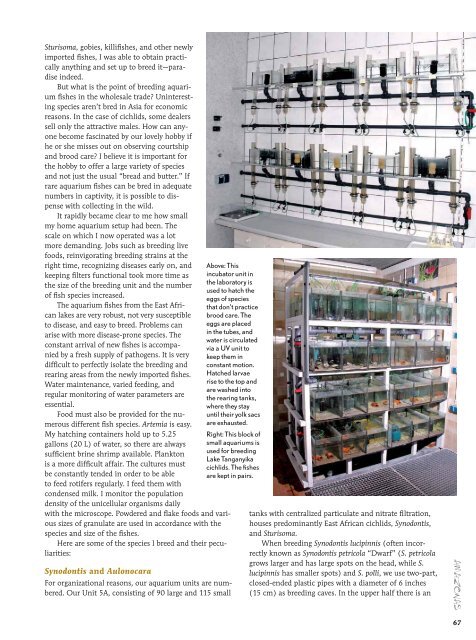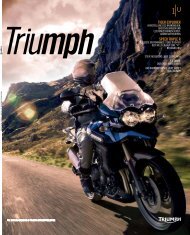Angels - PageSuite
Angels - PageSuite
Angels - PageSuite
You also want an ePaper? Increase the reach of your titles
YUMPU automatically turns print PDFs into web optimized ePapers that Google loves.
Sturisoma, gobies, killifishes, and other newly<br />
imported fishes, I was able to obtain practically<br />
anything and set up to breed it—paradise<br />
indeed.<br />
But what is the point of breeding aquarium<br />
fishes in the wholesale trade? Uninteresting<br />
species aren’t bred in Asia for economic<br />
reasons. In the case of cichlids, some dealers<br />
sell only the attractive males. How can anyone<br />
become fascinated by our lovely hobby if<br />
he or she misses out on observing courtship<br />
and brood care? I believe it is important for<br />
the hobby to offer a large variety of species<br />
and not just the usual “bread and butter.” If<br />
rare aquarium fishes can be bred in adequate<br />
numbers in captivity, it is possible to dispense<br />
with collecting in the wild.<br />
It rapidly became clear to me how small<br />
my home aquarium setup had been. The<br />
scale on which I now operated was a lot<br />
more demanding. Jobs such as breeding live<br />
foods, reinvigorating breeding strains at the<br />
right time, recognizing diseases early on, and<br />
keeping filters functional took more time as<br />
the size of the breeding unit and the number<br />
of fish species increased.<br />
The aquarium fishes from the East African<br />
lakes are very robust, not very susceptible<br />
to disease, and easy to breed. Problems can<br />
arise with more disease-prone species. The<br />
constant arrival of new fishes is accompanied<br />
by a fresh supply of pathogens. It is very<br />
difficult to perfectly isolate the breeding and<br />
rearing areas from the newly imported fishes.<br />
Water maintenance, varied feeding, and<br />
regular monitoring of water parameters are<br />
essential.<br />
Food must also be provided for the numerous<br />
different fish species. Artemia is easy.<br />
My hatching containers hold up to 5.25<br />
gallons (20 L) of water, so there are always<br />
sufficient brine shrimp available. Plankton<br />
is a more difficult affair. The cultures must<br />
be constantly tended in order to be able<br />
to feed rotifers regularly. I feed them with<br />
condensed milk. I monitor the population<br />
density of the unicellular organisms daily<br />
with the microscope. Powdered and flake foods and various<br />
sizes of granulate are used in accordance with the<br />
species and size of the fishes.<br />
Here are some of the species I breed and their peculiarities:<br />
Synodontis and Aulonocara<br />
For organizational reasons, our aquarium units are numbered.<br />
Our Unit 5A, consisting of 90 large and 115 small<br />
Above: This<br />
incubator unit in<br />
the laboratory is<br />
used to hatch the<br />
eggs of species<br />
that don’t practice<br />
brood care. The<br />
eggs are placed<br />
in the tubes, and<br />
water is circulated<br />
via a UV unit to<br />
keep them in<br />
constant motion.<br />
Hatched larvae<br />
rise to the top and<br />
are washed into<br />
the rearing tanks,<br />
where they stay<br />
until their yolk sacs<br />
are exhausted.<br />
Right: This block of<br />
small aquariums is<br />
used for breeding<br />
Lake Tanganyika<br />
cichlids. The fishes<br />
are kept in pairs.<br />
tanks with centralized particulate and nitrate filtration,<br />
houses predominantly East African cichlids, Synodontis,<br />
and Sturisoma.<br />
When breeding Synodontis lucipinnis (often incorrectly<br />
known as Synodontis petricola “Dwarf” (S. petricola<br />
grows larger and has large spots on the head, while S.<br />
lucipinnis has smaller spots) and S. polli, we use two-part,<br />
closed-ended plastic pipes with a diameter of 6 inches<br />
(15 cm) as breeding caves. In the upper half there is an<br />
AMAZONAS 67




